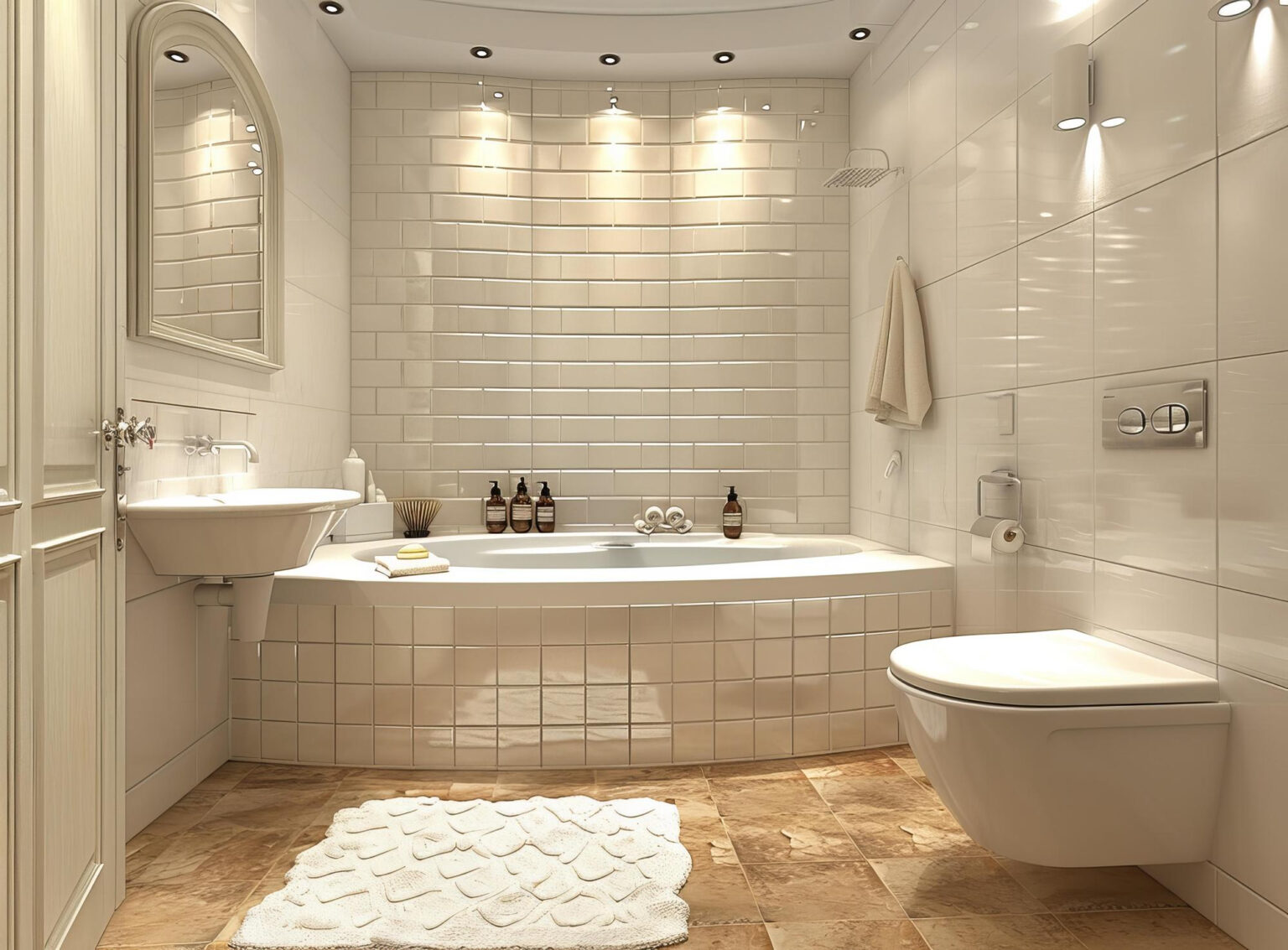Bathroom tiles play a crucial role in the overall look and feel of a bathroom. Choosing the right tiles can enhance design, offer practical benefits, and transform a space into a stylish retreat. With so many types, sizes, and styles available, homeowners have a vast array of options to suit their personal taste and needs.
Selecting the ideal bathroom tiles involves understanding various materials, such as ceramic, porcelain, and natural stone. Each type has its own unique characteristics and maintenance requirements, making it essential to choose wisely based on the bathroom’s use and design. Trends in tile design continue to evolve, with bold patterns and versatile shapes gaining popularity, giving homeowners the chance to express their individuality.
Finding the perfect balance between aesthetics and functionality is key when updating a bathroom. Proper installation techniques and ongoing maintenance are important to ensure tiles remain beautiful and durable over time. This article will explore various bathroom tile options, their installation, and the latest design trends to inspire any renovation project.
Key Takeaways
- There are many types of bathroom tiles to choose from, each with distinct features.
- Proper installation and care are vital for maintaining tile quality.
- Current trends in bathroom tiles emphasize personalization and unique design styles.
Types of Bathroom Tiles
Bathroom tiles come in various types, each with unique features. Understanding these differences helps in choosing the right tiles for specific needs and styles.
Ceramic and Porcelain Tiles
Ceramic and porcelain tiles are popular choices for bathrooms. They are both made from clay and fired at high temperatures, making them durable and water-resistant.
Ceramic Tiles
- Cost: Generally more affordable
- Variety: Available in many colors, shapes, and sizes
- Maintenance: Easy to clean with water and mild detergent
Porcelain Tiles
- Durability: Denser and less porous than ceramic
- Installation: Can be used for both floors and walls
- Design: Often imitates natural stone or wood
Both options offer versatility for different bathroom designs.
Natural Stone Tiles
Natural stone tiles add a luxurious touch to bathrooms. Common types include marble, granite, and slate. Each type has distinct characteristics that appeal to different tastes.
- Marble: Elegant and classic, but can be porous. Regular sealing is necessary to prevent stains.
- Granite: Extremely durable and heat-resistant; a great choice for high-traffic areas.
- Slate: Offers a rustic look and is slip-resistant, making it safe for wet environments.
Natural stone tiles require more maintenance than ceramic options but offer unmatched beauty.
Glass Tiles
Glass tiles are a trendy option for modern bathrooms. They can create a stunning visual effect with their reflective surfaces.
- Light Reflection: Glass tiles can make a space feel larger and brighter.
- Variety: Available in various colors and finishes, including frosted and glossy.
- Ease of Cleaning: Non-porous, making them easy to maintain and resistant to mold.
They are often used in accents, backsplashes, or entire walls to add visual interest.
Cement Tiles
Cement tiles are known for their unique patterns and colors, adding character to bathrooms. They are made from a mixture of cement, pigments, and aggregates.
- Design Flexibility: Available in countless designs, allowing for creative expressions.
- Durability: While sturdy, they can be prone to staining if not sealed.
- Comfort: They stay cool underfoot, which can be a plus in warm climates.
Regular maintenance and sealing can enhance their longevity.
Mosaic Tiles
Mosaic tiles are small tiles that create intricate designs and patterns. They can be made from various materials, including glass, ceramic, and stone.
- Size Options: Typically, each tile measures 2 inches or smaller.
- Versatility: Used as accents or to cover entire surfaces, including floors and walls.
- Customizability: They can be arranged in various ways for unique designs or themes.
Mosaic tiles can add visual interest and texture to any bathroom space.
Tile Sizes and Shapes
Choosing the right tile size and shape can greatly affect the look and feel of a bathroom. Different tile sizes and shapes offer various design opportunities, making it important to understand the options available.
Standard Tile Sizes
Standard tile sizes come in various dimensions to suit different areas of a bathroom. Common sizes include:
- 4 x 4 inches: Good for small areas, like shower walls.
- 12 x 12 inches: A popular choice for floors and walls, it balances size and ease of installation.
- 24 x 24 inches: Ideal for larger spaces, giving a modern look with fewer grout lines.
Larger tiles can make a space feel bigger, while smaller tiles tend to create a busier appearance. The choice often depends on bathroom size and personal style.
Geometric and Unique Shapes
Geometric tiles add a special touch to bathroom design. Shapes like hexagons, triangles, and diamonds are becoming more popular.
These unique shapes can create interesting patterns and visual effects. For example:
- Hexagonal tiles can be arranged in honeycomb patterns for a modern feel.
- Chevron or herringbone styles can add a dynamic element to floors or walls.
Choosing unusual shapes lets a designer show creativity and can help the bathroom stand out.
Mosaic and Smaller Formats
Mosaic tiles are smaller and come in various designs. They usually measure 1 x 1 inch to 2 x 2 inches. These tiles are flexible for creating intricate patterns and adding texture.
Mosaics work well in several areas:
- Shower floors offer better grip.
- Accent walls can highlight specific areas, like a backsplash.
Due to their small size, mosaics can fit around curves or details in a bathroom design, enhancing its aesthetic appeal.
Installation and Maintenance
Proper installation and ongoing maintenance are essential for the durability and appearance of bathroom tiles. Understanding preparation, installation techniques, grouting, sealing, and cleaning will help achieve the best results.
Preparing for Installation
Before installing bathroom tiles, preparation is key. The surface must be clean, dry, and free from debris. This ensures proper adhesion and prevents future issues.
- Choose the Right Tools: Gather tools like a tile cutter, notched trowel, and level.
- Measure the Area: Accurate measurements of the floor or wall area help determine how many tiles are needed.
- Plan the Layout: Use a chalk line to mark the layout. Starting from the center or a straight edge helps maintain symmetry.
Additionally, it is wise to acclimate tiles for at least 24 hours by leaving them in the bathroom. This helps prevent issues from temperature changes.
Installation Techniques
When laying tiles, attention to technique ensures a professional finish. Begin with the backer board installed over the subfloor. This provides a stable base.
- Apply Thin-set Mortar: Use a notched trowel to spread thin-set mortar over a small section of the surface.
- Place the Tiles: Start laying tiles from the center and work outward, pressing down firmly.
- Cut Tiles as Needed: Use a tile cutter to cut tiles around edges and corners. Ensure that cuts are clean for a neat finish.
Allow the mortar to set as recommended, usually 24 hours, before moving on to grouting. This prevents shifting and misalignment.
Grouting and Sealing
After tiles are set, grouting fills the spaces between them. This step is crucial for both aesthetics and water resistance.
- Mix the Grout: Follow the manufacturer’s instructions for mixing. It should have a smooth consistency.
- Apply Grout: Use a rubber float to spread grout over the tiles, pressing it into the joints. Wipe off excess grout as you go.
- Curing Time: Allow the grout to cure according to instructions, typically for at least 48 hours.
Once the grout has cured, sealing is important. A sealant protects the grout from moisture and stains, ensuring long-lasting appearance and performance.
Cleaning and Repairs
Routine cleaning keeps bathroom tiles looking fresh. Use mild cleaners or pH-balanced solutions along with warm water. Avoid harsh chemicals that can damage the tiles or grout.
- Daily Maintenance: Wipe down tiles with a damp cloth to remove water spots and soap residue.
- Deep Cleaning: For stubborn stains, a soft brush and gentle cleaner can help without scratching the surface.
If a tile becomes damaged, repairs can be made effectively. Use a chisel to remove the broken tile, then clean up any debris. Apply thin-set mortar, place the new tile, and grout as described earlier. This ensures the integrity of the tile installation.
Design Trends and Aesthetics
Current trends in bathroom tiles showcase a blend of color, texture, and sustainability. Stylish designs enhance the atmosphere while also considering environmental impacts.
Color and Pattern Trends
Bold colors and intricate patterns are popular in bathroom tiles for 2024. Shades like peach, green, and deep blue add vibrancy, while classic black and white tiles maintain elegance. Non-traditional floral designs are also making a comeback with unique color combinations.
Geometric shapes and large-format tiles create a modern look, making spaces appear larger. For example, hexagonal tiles can serve as a focal point, while herringbone patterns add visual interest. The right color palette can transform a bathroom into a personal sanctuary.
Texture and Finish Variations
Textures and finishes play a crucial role in tile design. Matte finishes are favored for their modern appeal, as they reduce glare and fingerprints. Glossy tiles, on the other hand, reflect light, adding brightness to smaller spaces.
Natural stone tiles, like travertine or slate, introduce organic textures. These surfaces evoke a feeling of nature, complementing spa-inspired designs. Anti-slip finishes are also key for safety in wet areas.
Mixing different textures can create depth and character. For instance, pairing smooth tiles with rough, hand-crafted options adds contrast, enhancing the overall aesthetic of the bathroom.
Eco-Friendly and Sustainable Options
Eco-friendly tiles are increasingly popular among homeowners seeking sustainable choices. Recycled materials, such as glass or ceramic, often feature in modern designs. These tiles not only reduce waste but offer unique visual appeal.
Bamboo and cork tiles are other sustainable alternatives, providing warmth and softness underfoot. Many brands now prioritize sustainability, ensuring that products meet environmental standards without sacrificing style.
Choosing sustainable options allows homeowners to express their style while promoting eco-conscious living. This trend aligns with a growing awareness of environmental impacts in home design.














